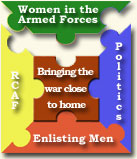

 |
|
 |
|
 With the need to free up men for the front lines, women were called into service with the armed forces. In 1941, the RCAF formed the women's division, which was followed by the formation of the Canadian Women's Army Corps. The navy was the last to fall in line, forming the Women's Royal Canadian Naval Service (Wrens). 50,000 Canadian women served in the military. Summerside women were ready to take up the call. Despite the entry into new occupations and surroundings, women forged ahead to fight a war. They served both overseas and in Canada. Their armed forces positions included jobs such as radio operators, mechanics, welders, armourers, parachute packers, administrative clerks, entertainment coordinators, ambulance drivers, jeep drivers, etc.
Women received two-thirds of the basic pay alloted to men.
With the need to free up men for the front lines, women were called into service with the armed forces. In 1941, the RCAF formed the women's division, which was followed by the formation of the Canadian Women's Army Corps. The navy was the last to fall in line, forming the Women's Royal Canadian Naval Service (Wrens). 50,000 Canadian women served in the military. Summerside women were ready to take up the call. Despite the entry into new occupations and surroundings, women forged ahead to fight a war. They served both overseas and in Canada. Their armed forces positions included jobs such as radio operators, mechanics, welders, armourers, parachute packers, administrative clerks, entertainment coordinators, ambulance drivers, jeep drivers, etc.
Women received two-thirds of the basic pay alloted to men.